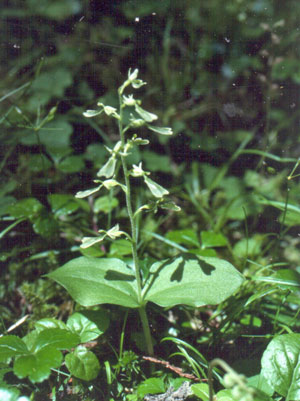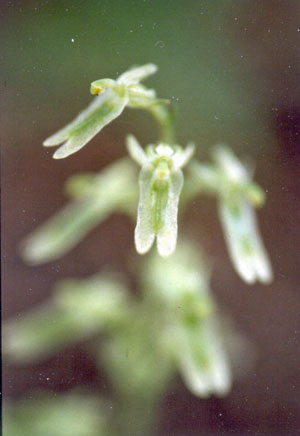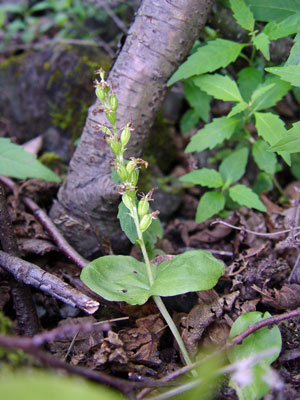DACF Home → Bureaus & Programs → Maine Natural Areas Program → Communities, Plants, and Animals → Rare Plants → Neottia auriculata

Neottia auriculata (Wieg.) Szlach.
Auricled Twayblade
- State Rank: S2
- Global Rank: G3G4
- State Status: Threatened
Habitat: Alluvial banks, calcareous silts or crevices, alder-thickets, and swamps. [Non-tidal rivershore (non-forested, seasonally wet); Forested wetland]
Range: Newfoundland and Quebec to New Hampshire and New York; Isle Royale, Michigan.

Aids to Identification: Auricled twayblade grows 10-25 cm tall, with one spike of up to about 20 small, pale green flowers. On the stem, there is a single pair of oppositely arranged leaves, 2-5 cm long, and rounded at the base. This species can be distinguished from the other species of Neottia (N. cordata and N. convallarioides) by the glandular hairs present on the axis of the inflorescence, flowers stalks, and ovaries (visible with a 10x handlens).
Ecological characteristics: In Maine, this species is often found growing underneath alders in alluvium of streams and rivers. Populations are typically small and may last only a few years.
Phenology: Flowers July - August.
Family: Orchidaceae

Synonyms: Bifolium auriculatum (Wieg.) Nieuwl.; Listera auriculata Wieg.; Ophrys auriculata (Wieg.) House.
Known Distribution in Maine: This rare plant has been documented from a total of 38 town(s) in the following county(ies): Aroostook, Franklin, Hancock, Oxford, Penobscot, Piscataquis, Somerset.
Reason(s) for rarity: At southern limit of range; habitat naturally scarce.
Conservation considerations: Known populations are small, and subject to the vagaries of small populations like random fluctuations or localized disturbance events. Populations have been known to be short-lived. Like all orchids, this plant should not be collected or dug. It is not known to have been successfully propagated, and any plants offered for sale have almost certainly been collected from the wild.
For more information, see the Native Plant Trust's Conservation Plan for Listera auriculata.